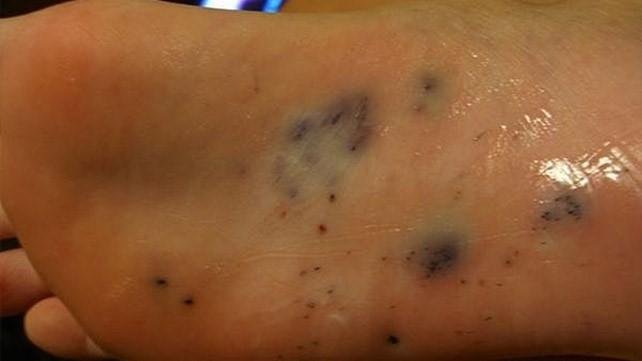
What to do if you're stung by a sea urchin
Peer reviewed by Dr Krishna Vakharia, MRCGPLast updated by Emily Jane BashforthLast updated 16 Aug 2022
Meets Patient’s editorial guidelines
- DownloadDownload
- Share
- Language
- Discussion
While many sea urchin stings can be mild and their symptoms go away within a few days, there is a possibility of them becoming seriously infected. Therefore, it's important to know how to act in these situations and when to seek professional help.
In this article:
Continue reading below
What are the symptoms of a sea urchin sting?
Sea urchin sting

Abbas Kanani, a pharmacist at Chemist Click, explains that, after being stung by a sea urchin, you'll see visible swelling around the area that has been stung, along with redness around the entrance point of the sea urchin spines. It's important to note that the colouring around the affected area could also be blue. The area will feel very sensitive and possibly sore, and if the sea urchin pierces the skin, you may see bruising.
You should be wary of any spines that have broken off within the body which could move deeper if not removed, as this can cause tissue, bone, or nerve injuries.
If a sea urchin stings you more than once, you could have more severe symptoms, which range from extreme shock to paralysis.
Other severe symptoms include:
Severe swelling around the affected area.
Severe bleeding.
Dizziness.
Loss of consciousness.
In extreme cases, particularly if left untreated, sea urchin stings can lead to infections and even death, which is why it's important to respond quickly and have them treated.
Are sea urchins poisonous?
Sea urchins have two types of venomous organs - spines and pedicellariae.
A sea urchin's spine is their natural sting. It happens when their venomous spikes puncture the skin and inject painful venom. They can penetrate deep and there's a risk of them breaking off inside the body.
On the other hand, the pedicellaria is a small wrench or claw-shaped appendage with a movable jaw. This is an active sting from the sea urchin that, if left to move deeper under the skin, could cause dermatitis, joint and muscle pain.
Continue reading below
What causes a sea urchin sting?
"Lightly touching a sea urchin doesn't usually trigger a sting, but if you add any amount of pressure - for example, stepping on a sea urchin - its pedicellariae will likely release venom and sting you," Kanani explains.
Basically, this is a sea urchin stinging out of instinct. It is their natural reaction to use their defence mechanism - which is always engaged - when feeling threatened or endangered. However, they also have a more active sting, which are the jaws
What is the deadliest type of sea urchin?
Sea urchins are typically found in areas with rocky bottoms. This could be shallow waters or deep-sea floors.
There are various kinds of sea urchins, the most dangerous being the flower sea urchin (Toxopneustes pileolus).
These sea urchins are so venomous that they can pierce through wetsuits. Flower sea urchins are found either individually or in groups, and are widespread in the Southeast Atlantic and Indo-West Pacific Ocean.
Meanwhile, the most common type of sea urchin is the sea chestnut. This species, (Paracentrotus lividus) is located in the Mediterranean Sea and Atlantic Ocean. They are common in up to 30 metres of water.
Continue reading below
How to treat a sea urchin sting
Kanani's top tips for treating a sea urchin sting yourself
Use tweezers to pluck out any of the urchin's spine left in the skin immediately. Don't use your bare hands.
Apply shaving cream and lightly scrape with a razor where a pedicellaria has entered the skin.
Soak the affected area in hot water for at least an hour.
Take over-the-counter painkillers such as paracetamol or ibuprofen to ease pain.
Apply topical creams such as hydrocortisone to reduce itching and inflammation.
Seek medical help if symptoms worsen or give you cause for concern.
When should you see a doctor for a sea urchin sting?
You should seek immediate medical help if you notice any signs of infection or experience the following symptoms:
Fatigue.
Difficulty breathing.
Loss of feeling in the body.
You should also see a doctor if your sting is a deep puncture wound. Try to answer their questions about how the sting happened and what your symptoms are as best as you can.
A few days after being stung, if your pain continues or your symptoms haven't improved, seek professional advice, as your sting could be infected.
There's a chance the sea urchin's spines may require surgical removal if they are too deep inside the body for you to remove yourself. Your doctor might also prescribe you antibiotics or send you to A&E if they believe it is necessary.
Potential complications of a sea urchin sting
Kanani assures that, with treatment, the pain and symptoms of a sea urchin sting should subside within five days.
However, complications are possible, especially if the venom penetrates deeply. For example, tissue necrosis (the death of body tissue) can lead to arthritis and joint stiffness.
In rare occasions, respiratory failure is a possibility, and should be treated immediately. Call the emergency services straightaway and they can provide oxygen and possible ventilation if needed.
While uncommon, paralysis and even death are possible, which is why responding quickly and treating a sea urchin sting are vital.
Tips for avoiding sea urchin stings
Observe sea urchins from afar - while nice to look at, they should not be touched.
Avoid swimming at night if the area is known to have sea urchins.
Wear water shoes for protection, particularly in shallow, rocky waters.
Tread carefully in water to avoid accidentally stepping on sea urchins.
Watch where you put your hands to avoid surprise contact with a sea urchin.
Patient picks for Stings and bites

Skin, nail and hair health
How to soothe a nettle sting
Stinging nettles grow widely across the UK and Europe. Whilst nettle stings aren't usually too serious, they can be in rare cases. Either way, it's important to know what to do if you or someone else is stung, to ease discomfort and to potentially save a life.
by Victoria Raw

Skin, nail and hair health
How to avoid tick bites and Lyme disease
If you've been keeping an eye on the news, you may be aware that Lyme disease is on the rise. A bacterial infection, which can be spread to humans via infected ticks, the condition was once both rarely diagnosed and rarely talked about. These days, however, it frequently makes headlines, with campaign groups on both sides of the Atlantic working to boost awareness.
by Abi Millar
Continue reading below
Article history
The information on this page is peer reviewed by qualified clinicians.
16 Aug 2022 | Latest version

Ask, share, connect.
Browse discussions, ask questions, and share experiences across hundreds of health topics.

Feeling unwell?
Assess your symptoms online for free
Sign up to the Patient newsletter
Your weekly dose of clear, trustworthy health advice - written to help you feel informed, confident and in control.
By subscribing you accept our Privacy Policy. You can unsubscribe at any time. We never sell your data.